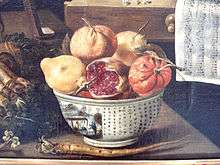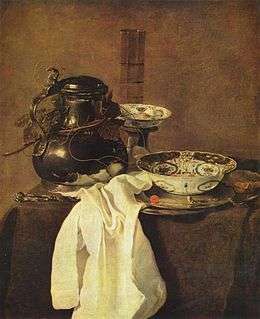Chinese porcelain in European painting



Chinese porcelain in European painting is known from the 16th century, following the importation of Chinese porcelain wares into Europe.
Italian precedents (15th–16th century)

In Italy, the first known depiction of Chinese porcelain bowls is from the The Feast of the Gods by Giovanni Bellini (1514).[1] The style of the bowls is that of the Ming dynasty blue and white porcelain type, maybe examples of which are known to have been exported in Persia, Syria and Egypt.[1] The painting by Bellini was a request by Duke Alfonso I d'Este, who was known for his interest in Chinese porcelain. It seems that Bellini found samples of the Chinese ware not through trade, but among diplomatic gifts received by Venice from the Mamluke Sultans in 1498 (gift to Doge Barbarigo), and in 1498 and 1508 (gift to the Signoria).[1]
Some earlier examples are known though, although it is unclear if they are Chinese or Islamic prototypes, as in the Madonna and Child by Francesco Benaglio (1460–70), or the Adoration of the Magi by Andrea Mantegna (1495–1505).[1]
Rest of Europe (17th–18th century)
In the 16th century, numerous other painters would use Chinese porcelain in their paintings, especially Dutch ones. This trend was related to the direct importation of Chinese porcelain to Europe, through what is known as "Carrak" trade, hence the name Kraak porcelain.[2][3]
French painters, such as François Desportes, also represented Chinese bowls in their still-life paintings. Some like Jacques Linard in 1627 even painstainkingly reproduced Chinese writing, in Les cinq sens et les quatre éléments, 1627.[4][5]
This artistic trend coinciding with the fashion for Chinese porcelain in Europe in the 17th–18th century, which led to the development of a local porcelain industry initially highly imitative of Chinese wares, as seen in French porcelain.
The Netherlands
-

Nature morte aux porcelaines et verres Jurian van Streek, Low Countries, 1660 1670.
-

Juriaen van Streek, Still-life with peaches and a lemon, 1636.
-

Jan Davidsz de Heem, Still Life with Fruit and Lobster, second half of 17th century; Oil on canvas, 75 × 105 cm; Museum Boymans-van Beuningen, Rotterdam.
-

Jan Davidszoon de Heem (1606–1683/4), A Banquet Still Life, Detail, 1642; Oil on Canvas; New York
-

Dutch 17th century still-life painting by Jan Jansz. Treck, 1649.
France
-

The 14th century Fonthill vase, painted by Barthélemy Remy in 1713.
-

Nature morte au gibier et à la coupe de porcelaine (detail), François Desporte, c. 1700–1710.
-

Jacques Linard, Les cinq sens et les quatre éléments, 1627.
See also
Notes
- 1 2 3 4 Bazaar to piazza: Islamic trade and Italian art, 1300–1600 by Rosamond E. Mack p.105ff
- ↑ Blanc de Chine: the great porcelain of Dehua by Robert H. Blumenfield, p.180
- ↑ Chinese export porcelain in the Reeves Center collection at Washington by Thomas V. Litzenburg, Ann T. Bailey, Reeves Center p. 14
- ↑ Permanent exhibit, Louvre Museum
- ↑ Consuming cultures, global perspectives by John Brewer, Frank Trentmann p. 104

